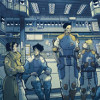



|
|
|
Title | Shangri-La
| |
Series | ---
| |
Author | Mathieu Bablet
| |
Illustrator | Mathieu Bablet
| |
Publisher | Ankama - 2020
| |
First Printing | Ankama - 2016
| |
Category | Graphic Novel
| |
Warnings | Animal abuse, rape
| |
Main Characters
|
Scott, Vergil, John
| |
Main Elements | Utopia/Dystopia
|
|

Dans un futur lointain de quelques centaines d’années, les hommes vivent dans une station spatiale loin de la Terre. La station est régie non pas par un gouvernement, mais par une multinationale à qui est voué un véritable culte. En apparence, tout le monde semble se satisfaire de cette « société parfaite ». Dans ce contexte, les hommes veulent repousser leurs propres limites et devenir l’égal des dieux. Et c’est en mettant en place un programme visant à créer la vie à partir de rien sur Shangri-La, une des régions les plus hospitalières de Titan, qu’ils comptent bien réécrire la « Genèse » à leur façon.

Whew, there is a lot of stuff packed into this graphic novel.
- Ecology - humans have wrecked the earth so we're all living on a space station
- Consumerism - the space station is basically run by a corporation and encourages people to constanly consume, putting out new phones which people must absolutely buy the day it comes out
- Racism - there are human/animal hybrids that are mistreated by the pure humans
- Animal abuse - next level down, animals are used to produce products in factories (that is an image I will never get out of my head, so very, very disturbing)
- Scientific ethics - humans are trying to play God, creating a new human race literally from scratch over which they can rule as gods, as well as messing with technology that has the power of wiping all of out
- And a spattering of other things, women get raped, another woman says she needed a male figurehead since no one would take a female (and a fox) seriously, dysfunctional families and more
Almost a cliche, as in most dystopias the main character thinks everything perfect, that he in fact lives in a utopia but then predictably has his eyes opened. But when he joins the resistance he finds they might not be any better than the current regime (one which he was quite happy with just a short time ago after all).
I struggled a bit trying to tie the first part of the story (which takes a million years in the past) and the end of the novel (which takes place in our near future) and what one had to do with the other. I mean I sorta got it, but other than the nova killing him, it had nothing to do with anything else. Or maybe it did, as he was...well the last while being the first...don't want to say too much. The ending was, well, depressing, but then maybe we got what we deserved while still leaving a glimmer of hope.
One thing though...I didn't like the art...I really disliked the human faces with their weird noses, and did something happen to the human race to cause them to have really tiny feet? I graphic novel doesn't have to be photorealistic (though the ones that are blow me away) but these were just, well, ugly. Although that art style served well to show the factory with the surgically altered animals...that image pops into my head from time to time and it is pure horror. I mean seriously people, you've got advanced tech, heck we have tech that can do what they were making those animals do, and you don't have to feed machines and make sure they don't get sick and stuff, it just made no sense whatsoever except to really shock the readers.
However, I am really really glad the artist didn't decide to go with his original idea of having light flares all over the place. I read another graphic novel series that went that route and it just made the art blurry, which would have made me like it even less, at least I could still appreciate all the detail that went into the stations and the ships! And there are some lovely views of space.
Overall though, it was a thought provoking read, assuming I'm not left with nightmares of mutated animals! The Island of Doctor Moreau has nothing on this book!
|